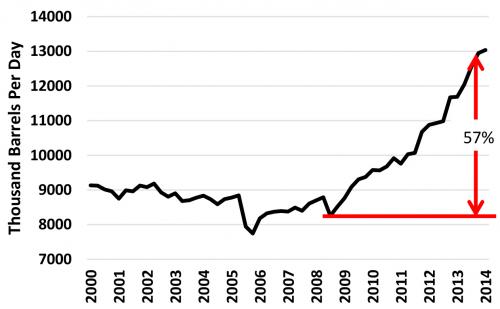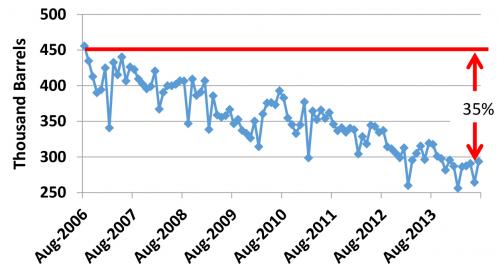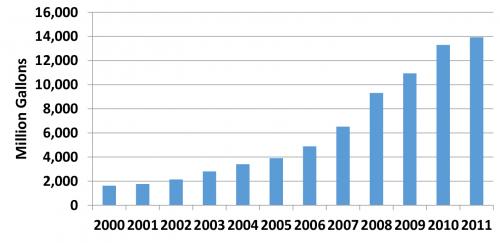United States is the world’s leading producer of petroleum
Increased oil and biofuel production lessen imports and hold prices steady at the pump.
The United States has been ramping up exploration and production of oil since 2009 and has now surpassed Russia and Saudi Arabi as the world’s largest producer of crude oil. In May 2014, the United States produced 13,535 barrels per day, outpacing Saudi Arabia by more than 1,900 barrels per day. The top five oil producing countries in May 2014 are shown in the table below.
World oil production by country (thousand barrels per day)
|
Rank |
Country |
May 2014 |
(%) |
|
1 |
United States |
13,525 |
14.8 |
|
2 |
Saudi Arabia |
11,608 |
12.7 |
|
3 |
Russia |
10,568 |
11.6 |
|
4 |
China |
4,476 |
4.9 |
|
5 |
Canada |
4,427 |
4.9 |
|
World |
91,162 |
Oil extraction from shale formations in North Dakota and Texas using a high pressure liquid process that fractures rock, commonly known as “fracking,” has been the primary source of new oil. Production has increased from 8,254 barrels per day in the third quarter of 2008 to 12,948 barrels per day in the fourth quarter of 2014, a 57 percent increase (Figure 1).
Figure 1. Historical U.S. oil production

As can be expected from increased domestic production, U.S. crude oil imports have decreased 35.5 percent in the past decade from 455,595 barrels in August 2006 to 293,644 barrels in July 2014. The top three countries we import oil from (in thousand barrels in July 2014) include Canada (101,721), Saudi Arabia (38,198) and Venezuela (27,945).
Figure 2. Total U.S. crude oil imports

United States production of ethanol, an alternative renewable fuel and oxygenate for gasoline, has also ramped up dramatically over the past decade. This is mostly due to the development of the Renewable Fuels Standard which requires fuel companies to blend renewable fuels in the supply stream. The majority of U.S. ethanol is produced from corn grain. Today, ethanol accounts for about 10 percent of fuel consumption by gasoline engines. Figure 3 shows historical production of ethanol in the United States.
Figure 3. Annual U.S. ethanol production

Given recent geo-political unrest in the Middle East, consumers might wonder why gasoline prices have not soared as they did in 2004-2006. With increased domestic production of crude oil and ethanol, we have been able to reduce our reliance on foreign oil. In addition, Americans are driving fewer miles in more fuel efficient vehicles. The combination of production and policies in the United States are having a positive impact on fuel prices.
Additional resources
- Ethanol and new car choices are helping Americans consume less petroleum, Michigan State University Extension
- Gasoline prices reach a new plateau, MSU Extension
- Petroleum and other liquids, U.S. Energy Information Administration
- Historical U.S. ethanol production, Renewable Fuels Association



 Print
Print Email
Email


